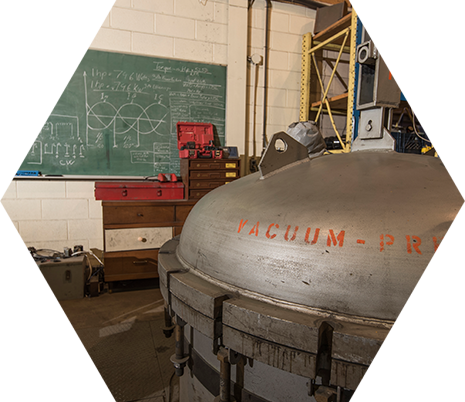Vacuum-Pressure Impregnation (VPI)A First In Northwestern Ontario
As Northwestern Ontario’s first VPI System (tank capacity 6.5 x 7), and new addition Vacuum Impregnation (tank capacity 3.5 x 6), Kilred Winding will save you money by decreasing the downtime on your electrical motors.
For a full description of the process, a tour of our facilities, or for a quotation on our many services, consult your Kilred Professional today.
Since we have installed our own VPI system, we have been asked many of the same questions over and over again by customers curious about the merits of vacuum-pressure impregnation.
Frequently Asked Questions
How does VPI work?
Our plant consists of a pressure vessel, chilled storage vessel, vacuum pumps, and baking facilities. The work-pieces are preheated to a predetermined temperature in an oven and then transferred to the pressure vessel. The lid is closed and the vessel is evacuated. The valve from the storage vessel is opened and resin is admitted until the workpiece is totally immersed. The valve is then closed and the vacuum maintained for a short period.
The vessel is then pressurized and held at this pressure for a predetermined time. The pressure is released, the lid is opened, and the job is transferred to the oven to complete curing. Apart from cleaning off any excess resin, the process is complete.
What are the applications for VPI?
VPI has a real advantage for users who require longer machine life and increased reliability where particularly harsh environmental conditions can arise in applications such as mining, chemical, marine, and food industries. VPI can increase tolerance to marginal overloading of machines because of the better heat transfer and elimination of hot spots, enabling heat to be dispersed through the structure of the machine.
VPI can be used to overcome problems of end winding movement, sometimes by VPI treatment alone and also by the addition of further bracing material before VPI treatment.
Is VPI new?
No. Vacuum pressure impregnation, using conventional varnishes, has been around almost as long as the electric motor itself. In the U.S., VPI using epoxy resin is a novel process for industrial electrical machines.
How much does VPI cost?
The resin is expensive, but there is little waste and no expense for solvents.
An insulation system expressly designed for VPI can mean a reduction in repetitive failures and excessive downtime.
What will VPI do?
VPI systems are suitable for the treatment of new machines, rewound machines, right through the range of electrical machines from fractional horsepower up to the limits imposed by capacity and tank size.
They are suitable on all machine voltages up to 11 kv, providing that the coils are manufactured with a conventional insulation system for this voltage.
They are suitable for stators, rotors, armature, field frames, and miscellaneous components like filed coils.
Depending on machine size, VPI is faster then the conventional varnish treatments.
A single VPI treatment is equivalent to two or three varnish dipping and bake cycles, depending upon machine size, the cycle time could be up to eight hours for a single treatment.
Will VPI solve problems?
Yes. For example, VPI fills the slot portions and the end windings 100% with epoxy resin. This means improved heat transfer by eliminating air/gas pockets and makes it impossible for moisture or other contamination to degrade the system. The solid void-free structure reduces the possibility of internal corona damage on high-voltage machines. VPI minimizes coil movement, slots are completely filled, and by the use of suitable fibers laminated structures and bracing materials a solid reinforced end winding structure is obtained. This ensures improved reliability and long service life.
The core wire is completely filled and sealed. This eliminates problems due to loose cores and provides positive protection against migration of moisture and other contamination through the core.
When required, fully sealed can be readily achieved by incorporating an additional end winding taping on random-wound machines and by double treatment of all types of machines. The VPI system can also resolve certain corrosion problems.
Can a VPI winding be repaired?
It is not feasible to carry out a partial rewind on a VPI treated machine. The risk of mechanical damage is greatly reduced by VPI treatment and the incidence of failure of such machines will be very low.

